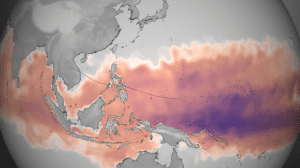
A map from the NOAA Environmental Visualization Laboratory shows the amount of heat energy available to Typhoon Haiyan between Oct. 28 and Nov. 3. Darker purple indicates more available energy. Typhoons gain their strength by drawing heat out of the ocean. The path of the storm is marked with the black line in the center of the image.
The deadly typhoon that swept through the Philippines was one of the strongest ever recorded, but storms nearly this powerful are common in the Pacific. Typhoon Haiyan’s devastation can be chalked up to a series of bad coincidences.
Typhoons”known in our part of the world as hurricanes”gain their strength by drawing heat out of the ocean. Tropical oceans are especially warm, which is why the biggest storms, Category 4 and Category 5, emerge there. These storms also intensify when there’s cool air over that hot ocean.
“The Pacific at this time of year is very ripe and juicy for big typhoons,” says Kerry Emanuel, a climate scientist at the Massachusetts Institute of Technology. “Once or twice a year we get a Category 5 typhoon out there.”
“But it’s a great rarity, fortunately, that a storm just happens to reach peak intensity when it’s making landfall. And that’s what happened in this case.”
Image courtesy of NOAA.

